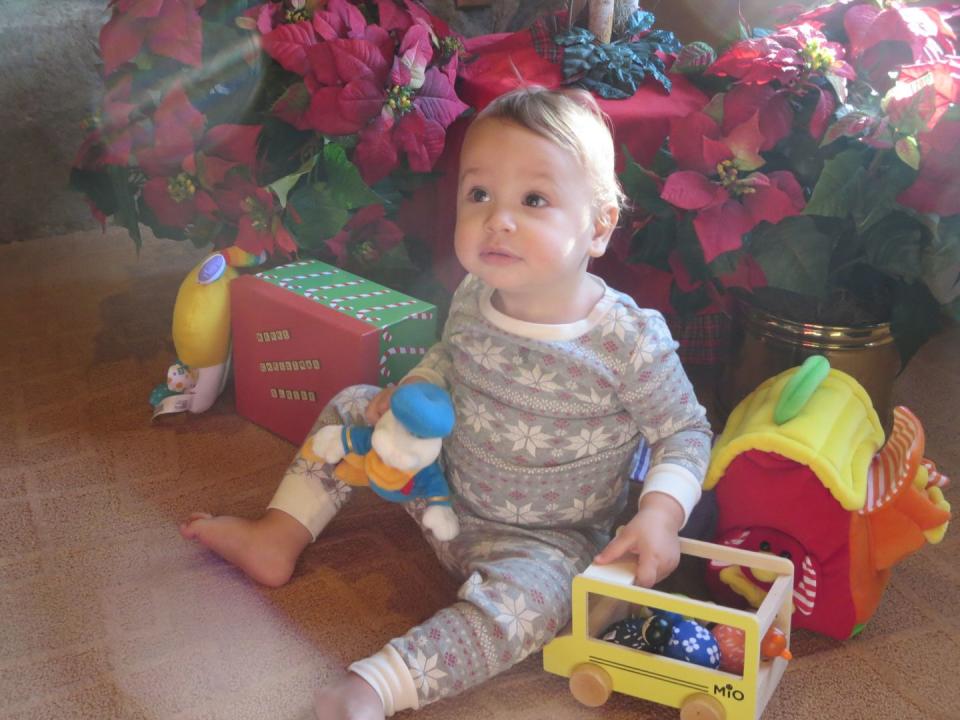Attention Grandmas: Studies Show It’s Better for Kids to Have Fewer Toys

I have a picture from my daughter's second Christmas that I cherish. She's sitting among poinsettias, in her fair isle holiday jams, with what looks like just a few, carefully curated toys in front of her. It looks like a classic Christmas morning.

What you can't see, just out of the frame, is the giant mountain of other toys her relatives bought for her. My daughter is the first grandchild on both sides of her family, and, well, she has very generous grandparents (and aunts and uncles and acquaintances and well-wishers). And every year, when her birthday and the holidays roll around, I get a knot in my stomach about the amount of stuff she gets. I think about sending out the word to ask everyone to tone it down, but I worry that I'll be labeled a Grinch who's ruining the fun of being a grandparent.
As it turns out, I'm right to feel queasy about the amount of gifts she's getting - and not just because of a lack of storage space and organization in my home. According to a study published earlier this year in the journal Infant Behavior and Development, an environment with fewer toys is better for kids. The researchers studied groups of toddlers, and gave them either four toys or 16 toys. According to Psychology Today, the kids who were given fewer toys focused more, were more engaged, played more creatively, and interacted with their toys in more varied ways for longer periods of time. “There was a significant difference in the quality of toddlers’ play between the two toy conditions,” the study concluded. In other words, less chaos can lead to increased focus and more joy. Makes sense.
And simpler toys are better, too: The American Academy of Pediatrics (AAP) recently put out a report saying that the best toys are non-electronic ones (read: no screens or apps). "The best toys are those that support parents and children playing, pretending, and interacting together," said Alan Mendelsohn, MD, FAAP, in an AAP statement. "You just don't reap the same rewards from a tablet or screen. And when children play with parents - the real magic happens, whether they are pretending with toy characters or building blocks or puzzles together."
That sounds like exactly what I want: a small collection of quality toys, just like in my photo. So, how do I get my family to sign on? I decided to enlist some professional help, and here's what the experts told me to do (besides forward those studies to everyone in my family):
Clear some space. To prepare for the incoming deluge of toys, I need to get rid of some old ones she doesn't play with anymore. I should ditch anything with broken or missing pieces - why do I hang on to those, anyway? - and consider passing on the toys she's outgrown developmentally. "When she’s old enough, have your child help you decide to give away to children who are less fortunate," says social psychologist Susan Newman, Ph.D. "Be sure to let her know - or take her with you to see - where her toys are going. It’s a good way to start building caring and empathy for others."
Don't keep everything for fear of blowback. Not that my resolve ever weakens for fear of toddler tantrums (ha ha), but my daughter might not mind parting with some of her toys if I'm upfront about it. "Although it probably seems like kids will be upset when parents put some toys away, many actually find it a relief," says Katie Hurley, LCSW, author of The Happy Kid Handbook. "Too many toys can feel chaotic. A simple explanation, 'We have more than we need right now; we can save some and share some and still have plenty of fun toys to use,' goes a long way toward helping kids learn an important message: It really is the thought that counts."
Ask for non-tangible things. I don't need another My Little Pony, but I'd be thrilled if someone picked up the tab for my daughter's soccer classes. "A great alternative to the massive number of presents that can accumulate is to ask relatives for the gift of experiences, like a museum family membership," says Emily Edlynn, Ph.D. "You could also ask for a gift that's spread out over the year, like a kids' magazine subscription, or a monthly activity subscription box. We know experiences are more gratifying than objects, so it can be much more meaningful than adding more toys to the pile."
Outings are even better. "Ask your gift-giving relatives to take your daughter to the zoo or park, or sled with her, or take her out for breakfast, and make it a standing date until her teen years when she will object," says Dr. Newman, the author of Little Things Long Remembered: Making Your Children Feel Special Every Day ("You don't do that with an excessive amount of gifts," she jokes.)
Just give up. Did I mention my mother-in-law works at a toy store? She's not really going to go for experiences no matter how solid of a case I make. In the end, I think I might just have to suck it up, accept the gifts, and pack some away for a rainy day, doling out her gifts over the ensuing months. Dr. Newman says the secret is just to not be sneaky about it. "What often works is asking a child which toys she wants to play with now and which ones she wants for later," Dr. Newman says. "If it's an unruly amount, a young child is apt to forget some items in the 'enormous' pile - you can hope for that."
('You Might Also Like',)

